Hoi An was one of my favourite cities in Vietnam, a cultural gem that effortlessly blends history, art, and traditional Vietnamese architecture. With lantern-lit streets, riverside charm, and a rich cultural heritage, Hoi An beckons travellers from far and wide. This guide delves into everything you need to know to visit Hoi An, so you can make the most of your trip!
Contents
How to Get to Hoi An
By air: Hoi An can be easily accessed through two main airports: Da Nang International Airport or Chu Lai International Airport. Several domestic and international airlines operate flights to these airports. Your best option is to fly into Da Nang, a 30-minute drive south to the heart of Hoi An. Alternatively, if you arrive at Chu Lai Airport, it will be around 1.5 hours drive. Taxis and private transfers are then readily available at both airports.
By bus: Hoi An is well-connected to major cities in Vietnam through an extensive bus network that runs between the North and South of Vietnam. If you are traveling from cities like Da Nang, Hue, or Nha Trang, you can easily find buses that will take you directly to Hoi An. The bus journey from Da Nang to Hoi An takes approximately one hour and costs around $2 to $4 USD. Buses are also available from other popular destinations like Ho Chi Minh City and Hanoi. You can book buses online through baolau.com or 12go.asia. Otherwise, simply ask your accommodation to book it for you (which is often cheaper).
By train: The closest railway station to Hoi An is Da Nang Railway Station. From here, you can connect to several cities in Vietnam. From Da Nang, you can take a taxi or a local bus to Hoi An, which is approximately 30 kilometers away. The train journey from cities like Ho Chi Minh City or Hanoi to Da Nang usually takes several hours, depending on the distance. Trains are less frequent than buses but offer generally more comfort.
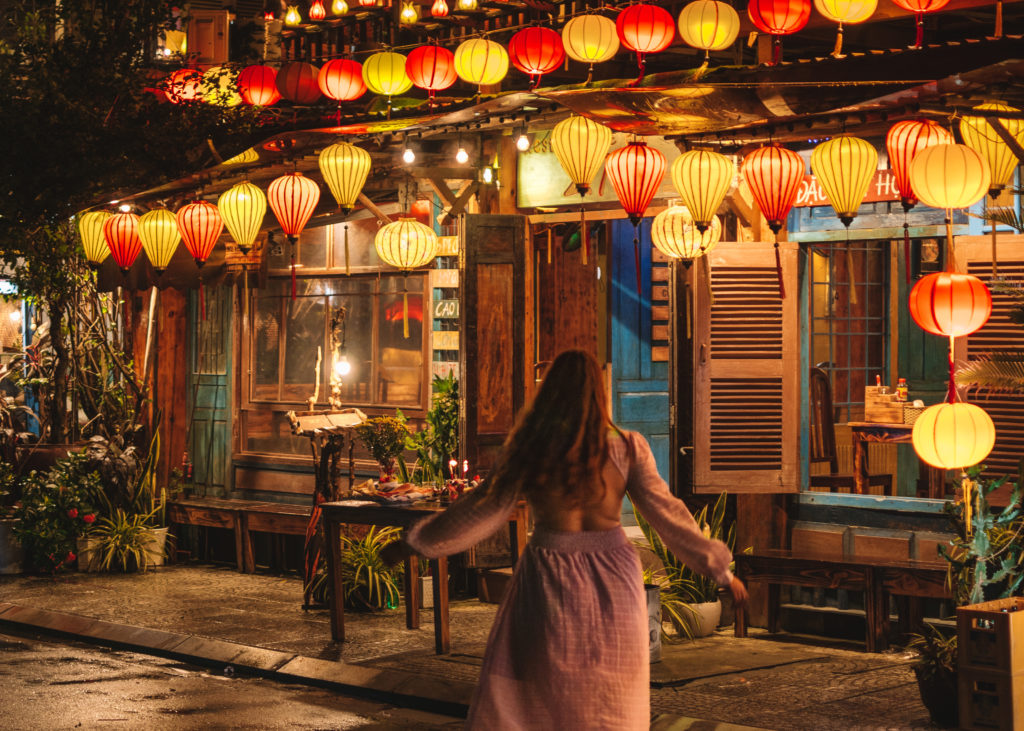
When to visit
The best time to visit is between February and May when the weather is just right, with mild temperatures and less rainfall. This period therefore allows you to explore the town comfortably. It is also best to avoid the peak tourist season in June and July, as the town can get crowded. By visiting during the shoulder seasons, you can enjoy a more chilled and intimate experience.
No matter what time of year you visit, I recommend planning your trip to coincide with the monthly Full Moon Lantern Festival. Hoi An is full of lanterns all year round, but it’s on another level for the Full Moon. Brightly coloured lanterns and boats line the streets and river, with the reflections shimmering on the water. They close the Ancient Town roads to vehicles and turn off the street lights so you can really see the lanterns!
What to do in Hoi An
Hoi An Ancient Town
The Ancient Town is the beating heart of Hoi An, with narrow, lantern-lined streets that feel like stepping back in time. The town’s well-preserved architecture showcases a harmonious blend of Vietnamese, Chinese, and Japanese influences, reflecting its rich cultural heritage. Explore shops and markets, indulge in local delicacies at riverside restaurants, and immerse yourself in the lively atmosphere. You can buy an entrance ticket to the Ancient Town for 120k VND (~$5 USD) that grants you access to 5 of the sightseeing places within the area, such as heritage buildings and museums.
Japanese Covered Bridge
One of Hoi An’s most iconic landmarks is the Japanese Covered Bridge. So iconic in fact, that it features on the 20,000 VND notes. Built in the 1590s, this ornate bridge gracefully spans the Thu Bon River, connecting the Japanese and Vietnamese quarters. Adorned with intricate carvings and a small shrine, the bridge is a testament to the town’s multicultural heritage. It’s a popular spot so I suggest visiting early, especially to take photos without the crowds. The bridge is included in the Ancient Town entrance ticket.
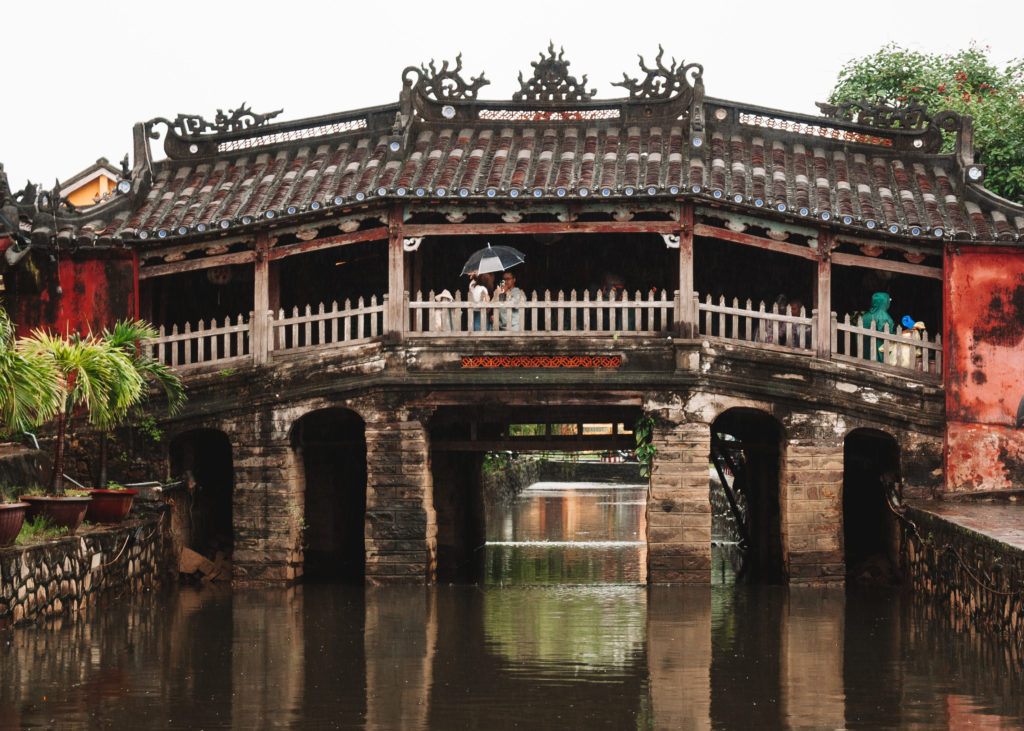
Tan Ky Old House
Journey back in time with a visit to Tan Ky Old House, a beautifully preserved merchant house that dates back more than two centuries. This architectural gem is a unique fusion of Vietnamese, Chinese, and Japanese influences. Marvel at the intricate woodwork, explore its atmospheric rooms, and learn about the house’s fascinating history. The entrance fee to Tan Ky Old House is also included in the Ancient Town entrance ticket.
Phuc Kien Assembly Hall
The Phuc Kien Assembly Hall, also known as the Fujian Assembly Hall, is a known for its elaborate architecture and peaceful courtyards. Built in 1690, it stands as a testament to the influence of the Fujian community in Hoi An. It is dedicated to the worship of Thien Hau, the Goddess of the Sea, revered by the seafaring Fujian community, with a temple for devotees to pay homage and seek blessings. The Phuc Kien Assembly Hall is not only a place of worship but also a cultural centre. It hosts festivals and traditional ceremonies throughout the year, offering visitors a fascinating glimpse into the vibrant traditions and heritage of Hoi An.
Lantern-Making Workshop
Immerse yourself in Hoi An’s artistic traditions with a lantern-making workshop. The workshop offers a hands-on experience, allowing you to choose your own fabrics and colours as well as the lantern style. If you have a bit more time on your hands you can even learn to make lanterns from scratch, including the frame. My recommendation is to go to The Lantern Lady, in the east of Hoi An. Prices start from around $6 USD, with a foldable lantern of your own to take home as a souvenir of your time in Hoi An.
Thu Bon River Boat Ride
Embark on a scenic boat ride along the Thu Bon River, where you can experience the magic of the shimmering lights reflected on the water. This is especially incredible during the Full Moon Lantern Festival. As you pass iconic landmarks, like the Japanese Covered Bridge, light a lantern and have your own Tangled moment. Boat rides are 150k VND (~$7 USD) and usually run from late afternoon to around 10pm.
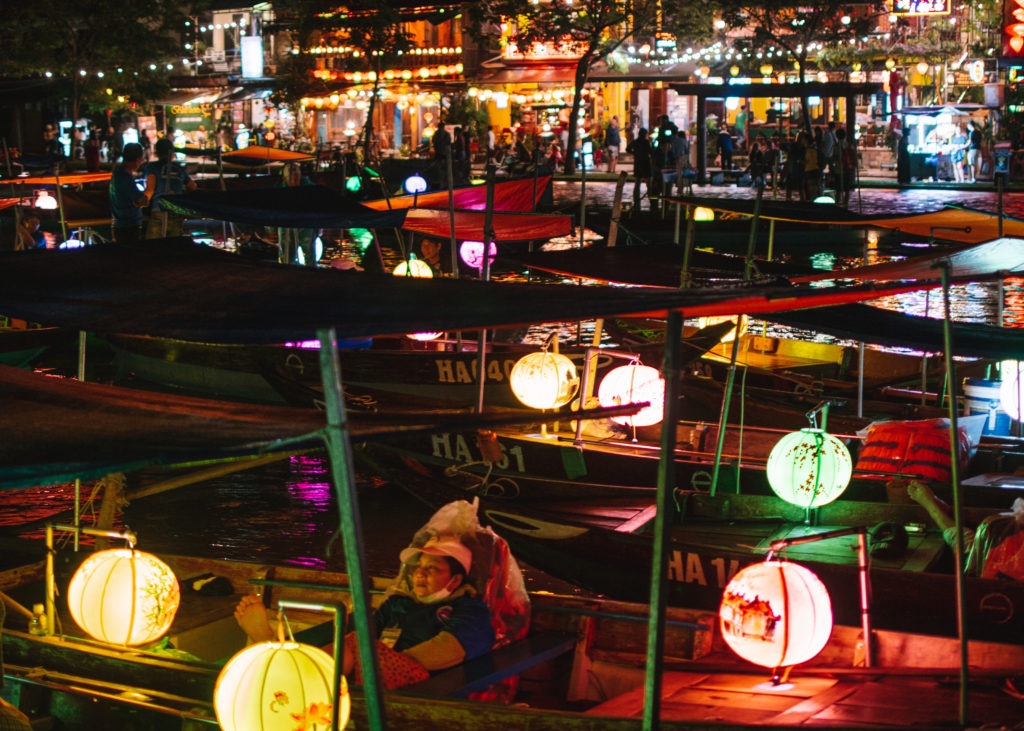
An Bang Beach
For beach lovers, An Bang Beach is near to Hoi An and popular with locals and travellers alike. Relax with a drink under the shade of palm trees, enjoy beachside massages, or try your hand at water sports. If the weather’s nice, it’s also the perfect escape from the heat of the city.
Coconut Boats
Explore the waterways of Hoi An on a coconut boat, a circular boat paddled by oar. This unique excursion offers an opportunity to learn about traditional fishing methods, try your hand at paddling the boat, and embrace the local culture. If you’re feeling especially brave, you can hop in a larger boat and spin around like crazy! Coconut boat rides are typically offered as part of a guided tour or can be arranged directly with local boat operators. The prices are generally reasonable. The price and duration of the ride does vary, however, depending on your preference and if you do activities.
My Son Sanctuary
Venture outside of Hoi An to explore the ancient ruins of My Son Sanctuary, a UNESCO World Heritage site. Situated in a lush valley surrounded by mountains, you’ll find a fascintating archaeological site of red-brick structures and intricate carvings. It is an important place to learn about the rich history of the Champa civilisation. Organised tours (or a car and driver) to My Son Sanctuary generally cost around $20 USD per person.
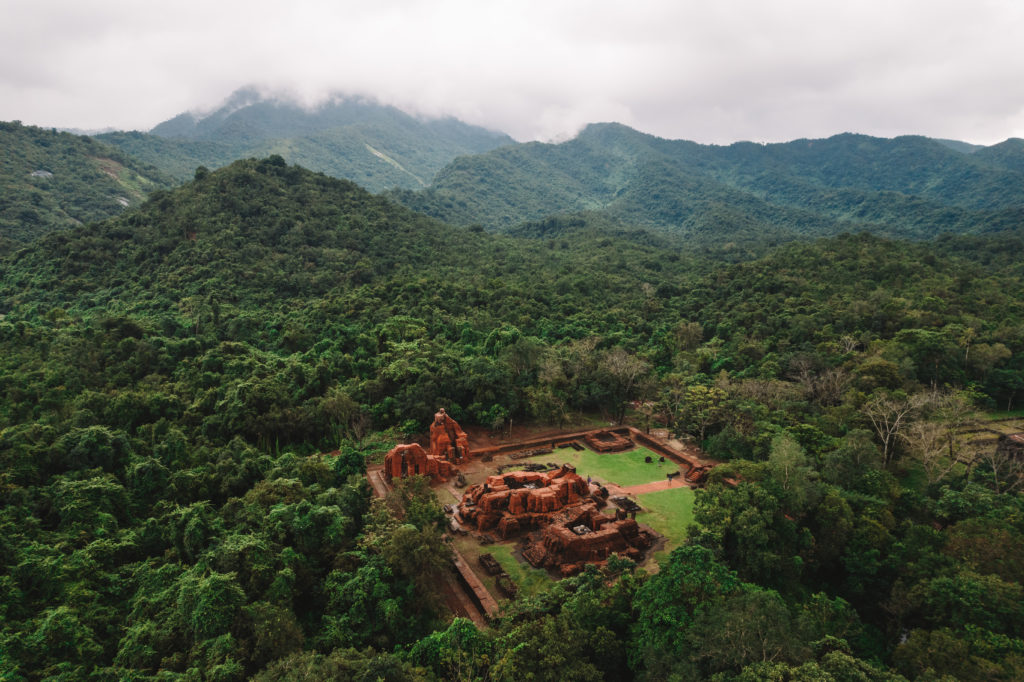
The Hoi An Tailors
The tailors in Hoi An are renowned worldwide for their craftsmanship. They can create amazing custom-made garments with both a quick turnaround time and reasonable prices. This tradition that dates back centuries and continues to this day, with hundreds of tailor shops around the city. These range from small family-run establishments to larger, more famous studios. You can choose from a huge selection of fabrics and designs, which are then fit to your precise measurements. It helps to go with an idea of what clothes you’d like, so they can bring your creations to life! Plan to be in Hoi An for at least 3 days so you can attend fittings and make any readjustments.
Eat all the banh mi
Hoi An is home to street food galore, including some of the best banh mi in Vietnam. Make sure to check out Banh Mi Phuong, a popular spot for both locals and tourists made famous by Anthony Bourdain. Another is the legendary Banh Mi Huynh Hoa. If these aren’t enough, head to Banh Mi Madam Khanh, also known as “The Banh Mi Queen”, and Banh Mi 25. These popular spots usually have queues, but they move quickly and the banh mi is worth the wait!

Where to stay in Hoi An
When it comes to finding the perfect place to stay in Hoi An, you’ll be spoilt for choice with a wide range of accommodation options to suit various budgets and preferences. Here are a few of my suggestions:
Hostel: SnapStay Hoi An
Budget: PaPa Villa Homestay
Mid-range: Hoi An Odyssey Hotel & Spa
High range: The Mansion Hoi An
Luxury: Almanity Hoi An Resort & Spa
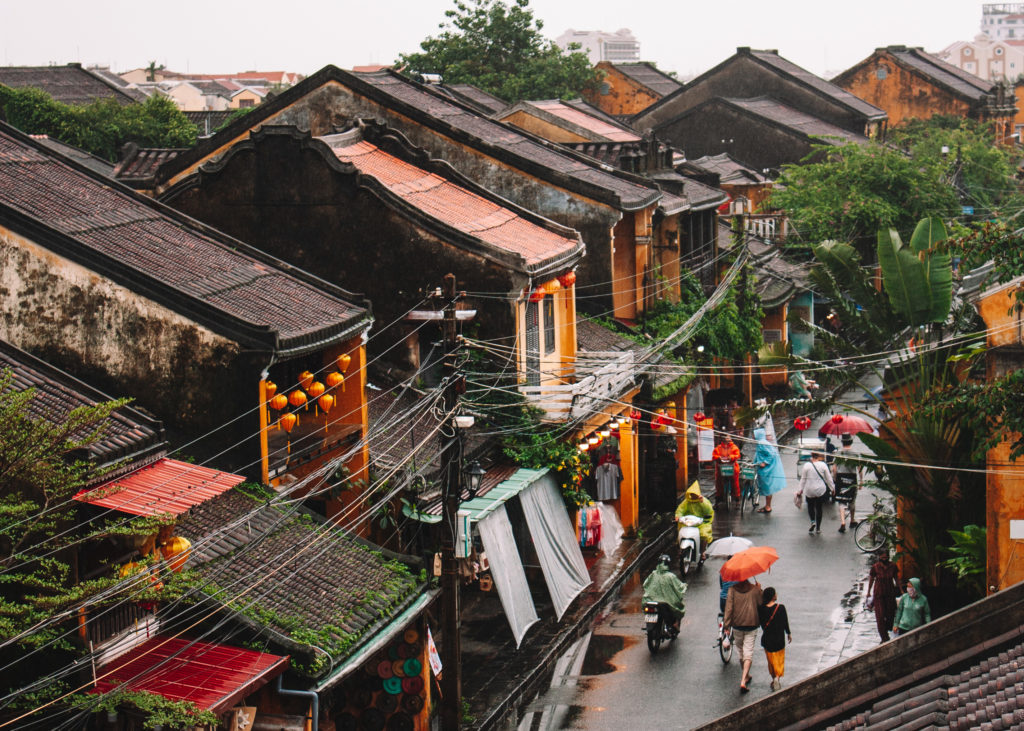
Planning your Vietnam trip
For detailed guides on Hoi An and everywhere in Vietnam, including where to visit, stay and eat, make sure to check out my Complete Guide to Vietnam here. You can also check out some of my blogs on other destinations here.



